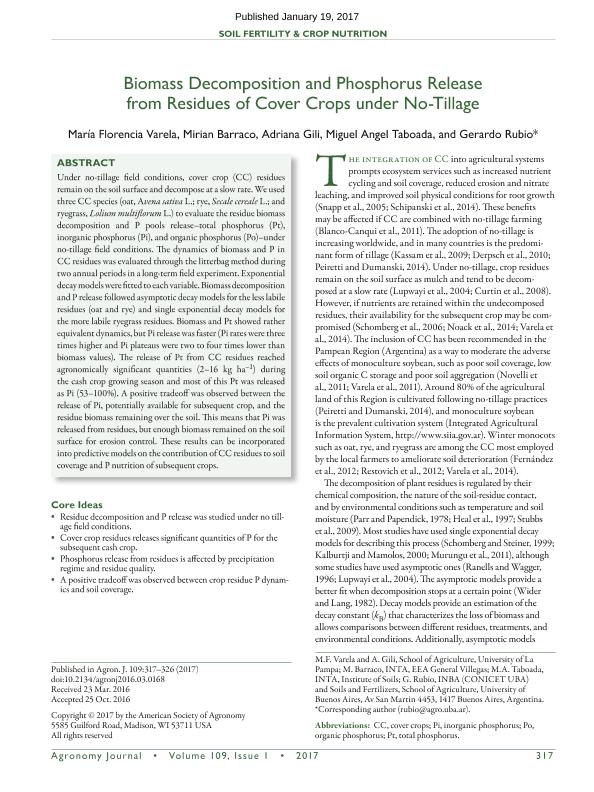Artículo
Biomass decomposition and phosphorus release from residues of cover crops under no-tillage
Varela, María Florencia ; Barraco, Mirian Raquel; Gili, Adriana Anahi
; Barraco, Mirian Raquel; Gili, Adriana Anahi ; Taboada, Miguel Angel
; Taboada, Miguel Angel ; Rubio, Gerardo
; Rubio, Gerardo
 ; Barraco, Mirian Raquel; Gili, Adriana Anahi
; Barraco, Mirian Raquel; Gili, Adriana Anahi ; Taboada, Miguel Angel
; Taboada, Miguel Angel ; Rubio, Gerardo
; Rubio, Gerardo
Fecha de publicación:
01/2017
Editorial:
American Society of Agronomy
Revista:
Agronomy Journal
ISSN:
0002-1962
Idioma:
Inglés
Tipo de recurso:
Artículo publicado
Clasificación temática:
Resumen
Under no-tillage field conditions, cover crop (CC) residues remain on the soil surface and decompose at a slow rate. We used three CC species (oat, Avena sativa L.; rye, Secale cereale L.; and ryegrass, Lolium multifl orum L.) to evaluate the residue biomass decomposition and P pools release–total phosphorus (Pt), inorganic phosphorus (Pi), and organic phosphorus (Po)–under no-tillage field conditions. The dynamics of biomass and P in CC residues was evaluated through the litterbag method during two annual periods in a long-term field experiment. Exponential decay models were fitted to each variable. Biomass decomposition and P release followed asymptotic decay models for the less labile residues (oat and rye) and single exponential decay models for the more labile ryegrass residues. Biomass and Pt showed rather equivalent dynamics, but Pi release was faster (Pi rates were three times higher and Pi plateaus were two to four times lower than biomass values). The release of Pt from CC residues reached agronomically significant quantities (2–16 kg ha−1) during the cash crop growing season and most of this Pt was released as Pi (53–100%). A positive tradeoff was observed between the release of Pi, potentially available for subsequent crop, and the residue biomass remaining over the soil. This means that Pi was released from residues, but enough biomass remained on the soil surface for erosion control. These results can be incorporated into predictive models on the contribution of CC residues to soil coverage and P nutrition of subsequent crops.
Palabras clave:
Nutrient Cycling
,
Soybean
,
Cover Crops
,
Pampean Region
Archivos asociados
Licencia
Identificadores
Colecciones
Articulos(INBA)
Articulos de INST.DE INVEST. EN BIOCIENCIAS AGRICOLAS Y AMBIENTALES
Articulos de INST.DE INVEST. EN BIOCIENCIAS AGRICOLAS Y AMBIENTALES
Articulos(SEDE CENTRAL)
Articulos de SEDE CENTRAL
Articulos de SEDE CENTRAL
Citación
Varela, María Florencia; Barraco, Mirian Raquel; Gili, Adriana Anahi; Taboada, Miguel Angel; Rubio, Gerardo; Biomass decomposition and phosphorus release from residues of cover crops under no-tillage; American Society of Agronomy; Agronomy Journal; 109; 1; 1-2017; 317-326
Compartir
Altmétricas



